2000 Long Form (ST3)
↓ Features
↓ Variables
↓ Geography
↓ Guided Tour
The Census 2000 Long Form is the most complete source of detailed information about the people, housing, and economy of the United States. The CensusCD/DVD 2000 Long Form offers the entire US Census Bureau's SF3 dataset in an integrated data and software package.
This dataset contains variables such as income, housing, employment, language spoken, ancestry, education, poverty, rent, mortgage, commute to work, etc. There are 5,500 variables at the Block Group level and over 10,000 more variables at the larger geographies such as tract, zip code, county and state level. For a complete list of variables, click here. The dataset includes all of the available cross-tabulated variables (income by age, employment by race) released by the US Census Bureau.
CensusCD/DVD 2000 Long Form, like all of our census-based products, comes with built-in data viewing and exporting capabilities as well as thematically shaded, color-mapping capabilities. With a few quick keystrokes you can generate full-blown maps or tables. You can extract data as dbf, ASCII, shape, or mid/mif files and use them as input files for other programs e.g. statistical (SAS, SPSS), database (Access, Oracle), spreadsheet (Excel, 1-2-3), and mapping (Arc View, MapInfo). You can even export any of the geographic boundaries into the mapping packages.
The intuitive software interface makes it simple to search for and select the data you're interested in. You can custom tailor reports down to the block group level, around a central point, or for a large array of areas all at once. 2000 Long Form even lets you create and map your own computed fields from the data.
How Can Census 2000 Long Form Benefit You?

Census 2000 Long Form lets you easily explore, analyze, and visualize an enormous amount of details about the people, housing, industry, economy, and places in the United States - right from your PC.
The data on Census 2000 Long Form is used every day by marketing analysts and researchers, media companies, utilities, community planners, health professionals, real estate consultants, business owners, social and political researchers, state and local governments, journalists and librarians. Anyone who needs detailed demographic information will benefit enormously from Census 2000 Long Form.
Census DVD Upgrade Release
The 2000 Long Form data set is so vast that even with our powerful compression it still took 4 CDs to hold all of the variables and geographies. Now we are offering the complete Long Form (SF3) on a single DVD. With the DVD, it is possible to run reports for the entire nation in a single pass. The 2000 Long Form DVD upgrade allows users to generate a single map of the entire US in the built-in map viewer.
- Complete Long Form Dataset on a SINGLE DVD
- Updated and Improved Census Tract & Block Group Boundaries
- Upgraded Version of the Map Viewer
Comparison Table
| Basic | |
|---|---|
| State User | $495.00 |
| National User | $995.00 |
| SF3 variable list | ✪ ~21500 variables |
CensusCD 2000/Long Form includes such categories of variables as income, housing, employment, language spoken, ancestry, education, poverty, monthly rent/mortgage, commute to work, etc. It contains about 16,000 variables at the tract, zip code level and above and about 5,500 variables at the Block Group level. For a complete list of variables, click here. The data set will include all of the cross-tabulated variables (income by age, employment by race) released by the US Census Bureau.
Geography
The CensusCD/2000 Long Form has data at 12 levels of geography:
- Nation (1)
- State (51)
- County (3,141)
- Tracts (65,232)
- Block Groups (208,790)
- Places (25,150)
- MCD/CCD (35,164)
- Congressional districts (436)
- Zip (ZCTA) (32,232)
- MSA/CMSA (280)
- CMSA/PMSA (76)
- American-Indian Reservations (651)
Guided tour
CensusCD 2000 Long Form Guided tour will lead you through the whole process of creating data reports and working with maps. Start with "Data" for a look at the different ways you can generate data from either program. Start with "Maps" to see the mapping features of CensusCD 2000 Long Form.
CensusCD 2000 Long Form is a powerful yet straightforward and easy to grasp tool.
You need to look up information or create a report... OK, just follow these five steps from the main menu:
1. Select Area
2. Select Subarea
3. Select Counts
4. Select Run
5. Select View

You can select an area, based on Tracts, Places or MCD or Block Groups. This is what you do:
This is what you do:
- Click a state
- Choose desired counties
- Choose tract(s)
- Choose places, MCD, or Block Groups
- Click Done
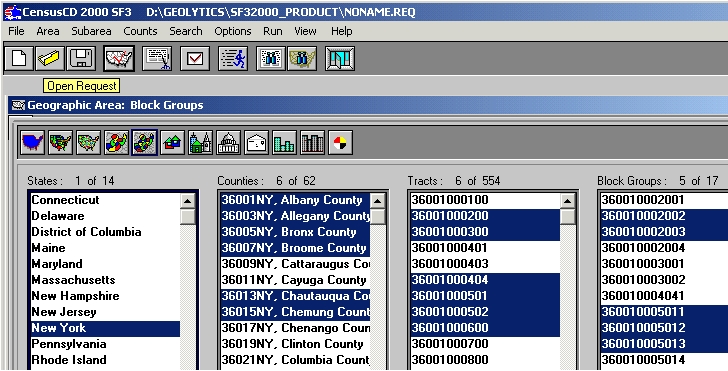
Sometimes you want to cover smaller units within a larger unit. You have completed selecting your area, which is this larger unity. Now, go to the Subarea menu to choose the smaller units. Click on the items offered there. Your report will be broken down into these smaller units; one report line for each of them.
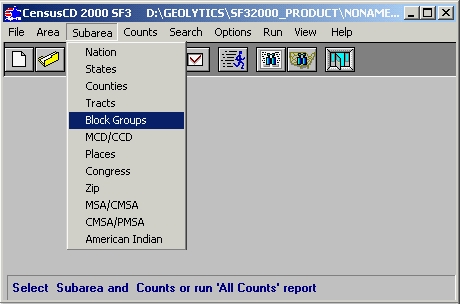
Once the areas are done, you can select what fields will be in your report. Select counts from the main menu and you'll see census demographics neatly grouped in 2 categories. Click a category button to to see the list of counts. Click a count to see it appear here and later in your report.
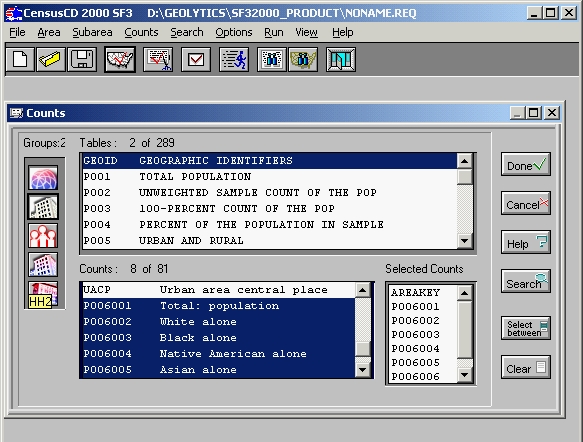
If you are not sure of the area, just click on search menu, enter information and click Find.

You can see all possible variations on the word "Bedford" in the USA
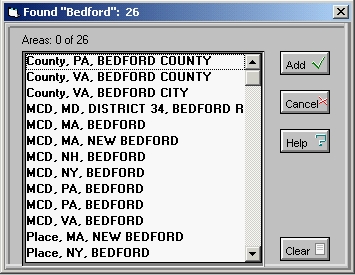
You can search for counts, too. Here we've used population as an example.

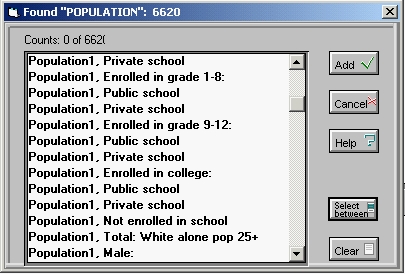
Easy to use options, allow you to focus your report on specific tasks and add-on features.

Now that you are all set, you can run your report.
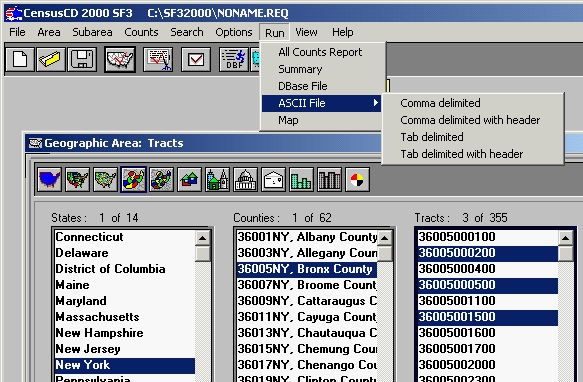
See the progress bar moving. This may be especially useful if you are generating a very large report.
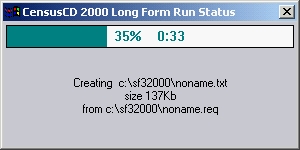
The report window is created when the report is done.
You can search, select, copy and print.
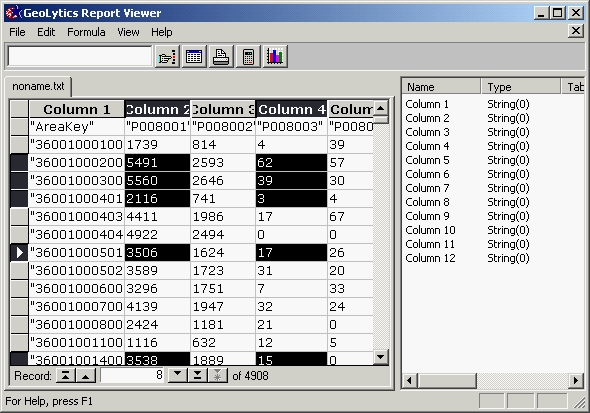
You can create charts using different algorithms.
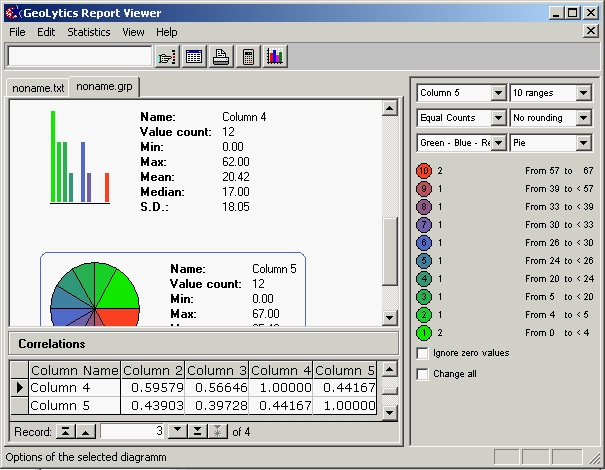
You can create the new fields on the fly using a formula calculator.
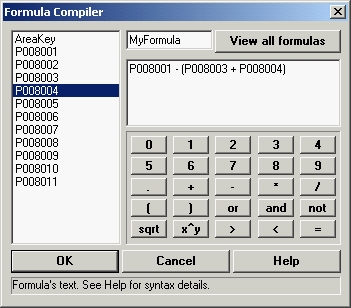
The status bar (located on the bottom of the application window) contains our "intelligent advice" messages that guide you every step of the way throuh the report creation process. Here is an example:

All this and many other things are explained in greater detail in our fully indexed help file.
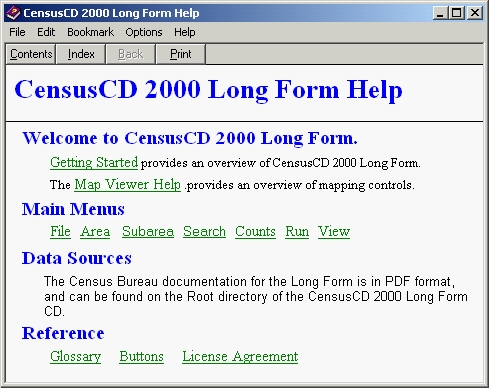
You can also map your report:
The ABC of thematic mapping with CensusCD 2000 Long Form is simple. First you create a report.
Let's take New York state as the area and select tracts as our subareas. You need to choose Census counts, too. Population/SEX BY AGE/Total: Population, Male:, Male Under 1 year, Male 1 year, ..., and Male 85+. Now you hit the Run Map button here:

The 1 784K report wil be created in a few seconds and now you see the map (we made it smaller than usual to save your loading time):
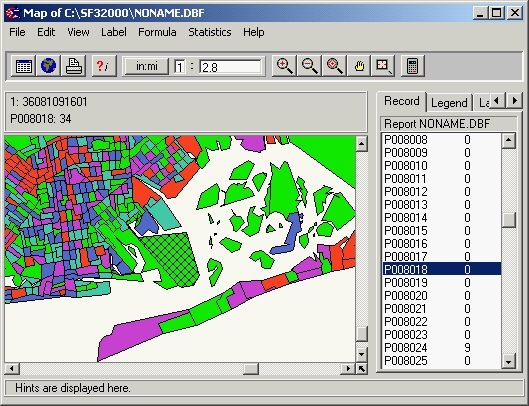
What you see is the distribution of the P008018 (Male 15 years) among New York state tracts using the "Equal counts" grouping algorithm with 5 ranges. This means that all areas were divided into 5 groups according to their values of P008018 so that each group has approximately the same number of areas.
Suppose what you really need is to see the Male 20 years and you want the areas to be sorted out into 5 groups, from 0% to 20% from P008023, from 20% to 40% and so on. Click on the P008023 line and see the map repainted. Now switch to the Legend Tab and select the Equal Ranges algorithm. What you see now is a differently colored map, mainly green because the P008023 for the most of state New York tracts is far below the maximum. Now you need to zoom a tract. Pick the Zoom Plus tool and click on the location several times. What you see is this:

What is this gren tract ID? Click on it using the ?i tool and switch to Area Tab.
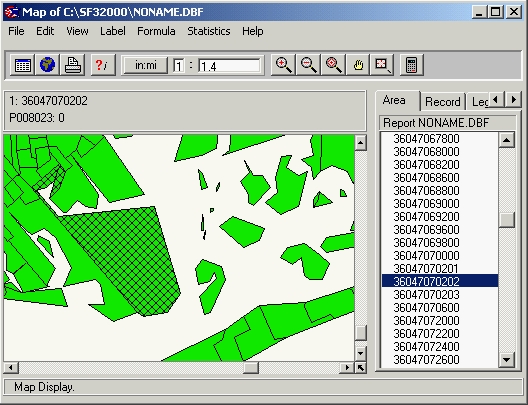
Aha. You see the whole tract 36047070202 highlighted. To find out where 36047070600 is, simply click on the line above and see...
This style of mapping is simple and intuitive but you can also do sophisticated things. Suppose you want to map characteristics that are not in the report Counts but can be computed from it. Let's assume it is the Total Population whose age is < 5 years. What you need, then, is to compute (P008003 + P008004 + P008005 + P008006 + P008007). This can be done by clicking the Calculator button:
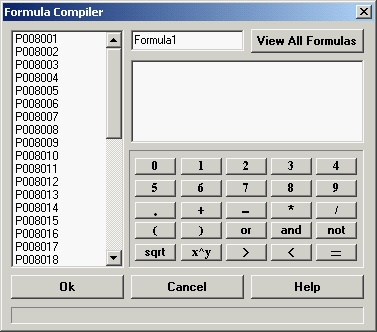
You see the full list of all the fields in the report and a "keyboard". Just type your formula and give it a name.
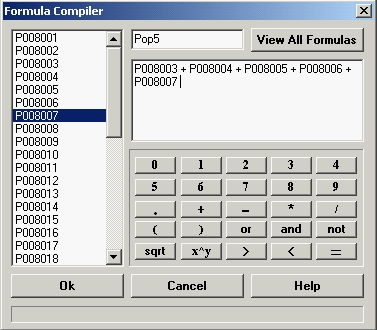
and press OK. The new virtual column will be added to the list of the report fields.
Click on the new virtual column and you will see it mapped:
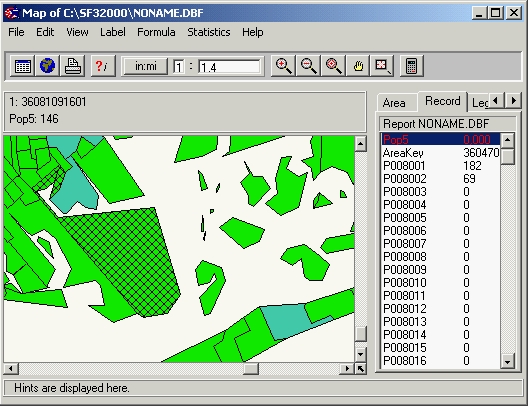
Of course, this is only the ABC of thematic mapping with CensusCD 2000 Long Form. We have a lot of nice features. Among those are:
- multiple layers capability
- search
- help
- customized print
- export to major GIS packages
- exports to clipboard and bitmap files
- customized color schemes
- customized groupping algorithms
... and more!
This is a great tool. Hope you will think so, too.




